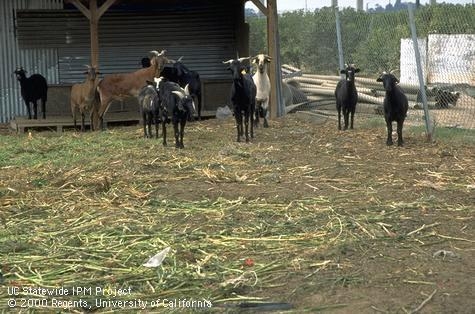What is the world's most popular meat?
I’ll bet a lot of you guessed chicken or pork. Some of you probably thought beef. Surprise! In the United States, we tend to consume chicken as our white meat of choice and beef as our red meat, but 63 percent of the world's population eats goat meat. Interestingly, more and more goat meat is being consumed in the United States and not just as an ethnic dish due to the growing ethnic population. The health-conscious consumer is also looking at the benefits of incorporating either cabrito (a delicacy meat from goats that are harvested between 1 to 3 months of age and weigh less than 50 pounds) or chevon (goats that are harvested between 6 to 9 months of age and weigh between 50 and 75 pounds). Older goat meat is also consumed but usually as sausage or in chili.
Mendocino and Lake livestock producers, especially those who want to sell local, might want to consider adding goats to their mix of cattle and/or sheep. I know some are already ahead of the curve (see our goat producer directory). Multi-species grazing on our rangelands not only provides economic diversity for the ranch but utilizes our rangeland forages better than single-species grazing. But let’s get back to that health-conscious consumer and why demand for goat meat is growing.
The table below shows the nutrient comparison of goat meat to traditionally raised chicken, beef, pork and lamb.
|
Nutrient composition of goat and other types of meat1, 2 |
|||||
|
Nutrient |
Goat |
Chicken |
Beef |
Pork |
Lamb |
|
Calories |
122 |
162 |
179 |
180 |
175 |
|
Fat (g) |
2.6 |
6.3 |
7.9 |
8.2 |
8.1 |
|
Saturated Fat (g) |
0.79 |
1.7 |
3.0 |
2.9 |
2.9 |
|
Protein (g) |
23 |
25 |
25 |
25 |
24 |
|
Cholesterol (mg) |
63.8 |
76.0 |
73.1 |
73.1 |
78.2 |
|
1 Per 3 oz. of cooked meat |
|||||
|
2 USDA Nutrient Database for Standard Reference, Release 14 (2001) |
|||||
You can see that goat meat is lower in calories, total fat, saturated fat, and cholesterol than the other meats. Less saturated fat and less cholesterol mean healthier red meat for the health-conscious consumer. Additionally, goat meat has higher levels of iron (3.2mg) when compared to a similar serving size of beef (2.9 mg), pork (2.7 mg), lamb (1.4 mg), and chicken (1.5 mg). Comparatively, goat meat also contains higher potassium and lower sodium levels. In terms of essential amino acids, goat meat closely resembles beef and lamb.
With these benefits, it’s clear why consumers are developing an interest in eating goat meat.
Comments:
Thanks for your comment. My blog article was not about goat meat being the "most" consumed meat in the world nor was it about it being the "most" eaten in the world. (Goat meat is one of the more popular meats consumed in developing countries).The purpose of the article was to stimulate interest in goat meat, especially in developed countries like the US. I also wanted to offer opportunities for US livestock producers to reap benefits of multi-species grazing as well as looking at a growing niche meat market. Finally I wanted to offer some information on the nutrient content of goat meat for both consumers and producers.
You'll notice that in my title and introductory paragraph I used the word "popular". The first definition for the word popular is: "liked, admired, or enjoyed by many people or by a particular person or group." (Source: Google Dictionary)
You'll also notice that I wrote "... 63% (2010 numbers, btw) of the world's population eats goat meat." This is based on a couple of references.
First, "Sixty per cent of the global population lives in Asia (4.4 billion), 16 per cent in Africa (1.2 billion), 10 per cent in Europe (738 million), 9 per cent in Latin America and the Caribbean (634 million), and the remaining 5 per cent in Northern America (358 million) and Oceania (39 million). China (1.4 billion) and India (1.3 billion) remain the two largest countries of the world, both with more than 1 billion people, representing 19 and 18 per cent of the world’s population, respectively. (Source: UN Population Division).
Second, "The goat belt stretches through Africa, Asia, South America, and the Caribbean. Goats are a staple in the developing world; according to the USDA, three quarters of the global goat population is found in developing countries."
Third, "The largest goat meat consuming country is China at 2.4 million tonnes in 2018 (tonnes is a metric ton, btw) and represents 40% of total consumption. India ranks second, and Pakistan, third. In 2018, the global production of goat meat totaled 5.9 million tonnes. Per capita consumption (kg per 1000 persons) for China in 2018 was 1,628. (Source: World- Goat Meat - Market Analysis, Forecast, Size, Trends and Insights 2019 Edition (basic). The source cited here is a fascinating and a recommended read and copies can be purchased on-line at: https://www.indexbox.io/blog/which-countries-consume-the-most-goat-meat/.
Again thanks for your comments as it gave me an opportunity to revisit some of the statistics and restate my article's objectives.
BTW, Susan Schoenian is a great resource. Glad you have her in your area. Wish she'd come to California!
Ergo, if you want to point out something about goats, just talk about goats without trying to trick people.


Posted by mu on December 2, 2014 at 9:57 AM